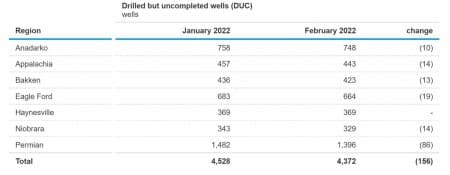Breaking News:

Chinese Mining Operations in Tajikistan Spark Environmental Backlash
Chinese mining and agricultural companies…

Volatility Dominates Oil Markets Amid Mixed Signals
It's been a rollercoaster of…
EIA: U.S. Shale Production Set For Big Jump In April
U.S. shale oil production in the seven most prolific shale basins are set for their biggest rise since March of 2020, according to new EIA data.
The Energy Information’s Drilling Productivity Report is estimating that the total production in the seven major U.S. shale basins will rise by 117,000 bpd next month, to 8.708 million bpd, according to the EIA’s latest version of the Drilling Productivity Report. The news comes as U.S. crude oil production finds itself in the spotlight as to the reasons they are not producing more.
Regardless of the EIA’s estimate for additional crude oil next month, projecting U.S. shale oil production, isn’t an exact science.
For its February report, the EIA had forecast that March’s crude production would reach 8.707 million bpd in the seven most prolific basins covered by the report. Instead, March’s production reached only 8.591 million bpd, with production in the Permian undershooting EIA forecasts by 60,000 bpd.
For April, the EIA now sees U.S. crude in the Permian rising from 5.138 million bpd to 5.208 million bpd—a 70,000 bpd rise. The Eagle Ford is expected to see the second largest increase with a 23,000 bpd rise to 1.146 million bpd. The Bakken is expected to increase by 16,000 bpd.
The EIA has estimated that the number of Drilled but Uncompleted wells (DUCs) fell 156 to 4,372 for the month of February. The DUC count—or fracklog—is often seen as a bellwether for the state of the oil industry. Higher DUC counts often signal that oil companies are comfortable spending money on wells that are unfinished and no producing. The DUC count in the United States has been falling since mid-2020.

The way the EIA calculates DUC wells, however, has been questioned, as there are numerous wells that have been unfinished for years and are extremely unlikely to ever be completed.
By Julianne Geiger for Oilprice.com
More Top Reads From Oilprice.com:
- Oil Prices Plunge As China Locks Down Shenzen
- Canada Says Its Oil Could Replace U.S. Imports Of Russian Crude
- Shale CEO: U.S. Can ‘’Easily’' Replace Russian Gas
Julianne Geiger
Julianne Geiger is a veteran editor, writer and researcher for Oilprice.com, and a member of the Creative Professionals Networking Group.
Open57.81
Trading Vol.6.96M
Previous Vol.241.7B

















US shale oil is a spent force. Producers haven’t been able to take advantage of rising oil prices and lift their production significantly not because of capital discipline as they claim but because they can’t. This has less to do with capital discipline and far more to do with their inability to raise production by much.
The reason is that the sweet spots in the shale plays have already been exhausted so shale drillers have had no alternative but to move to the less productive and more expensive to produce plays. Another reason is that well productivity has been on the decline adding to costs of production. And yet another reason is that shale drillers have far less access to capital than before the pandemic. Investors want good returns on their investments rather than reckless and unprofitable production as was the case before 2019.
US shale oil production can’t rise this year beyond an estimated 200,000-300,000 b/d above its average production of 11.0 mbd in 2021.
Dr Mamdouh G Salameh
International Oil Economist
Visiting Professor of Energy Economics at ESCP Europe Business School, London